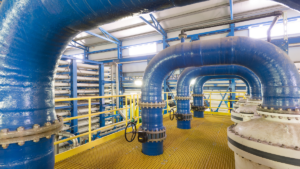Desculpe, este conteúdo só está disponível em English. For the sake of viewer convenience, the content is shown below in the alternative language. You may click the link to switch the active language.
Desalination, the process of removing salt and impurities from seawater or brackish water to produce freshwater, is playing an increasingly vital role in addressing global water scarcity. In this blog, we’ll explore the significance of desalination, its methods, benefits, and challenges, as well as its potential to provide clean and sustainable freshwater sources in the face of growing demand.
The Growing Need for Freshwater
The availability of freshwater is a critical factor in the well-being of communities and ecosystems worldwide. However, a variety of factors, including population growth, industrial expansion, climate change, and pollution, have placed unprecedented stress on global water resources. As a result, water scarcity has become a pressing concern, affecting billions of people.
Desalination is a process that holds the promise of providing a reliable and sustainable source of freshwater. It involves removing dissolved salts and other impurities from seawater, brackish water, or even wastewater to make it suitable for drinking, irrigation, industrial use, and more. The two primary methods of desalination are:
- Distillation:
Multi-Effect Distillation (MED): This method uses a series of evaporators and condensers to heat the seawater and collect the freshwater vapor. It’s an energy-intensive process but is highly effective at removing salts.
Multi-Stage Flash Distillation (MSF): MSF involves multiple stages of heating and flashing to produce freshwater vapor. Each stage operates at a lower pressure, allowing for the removal of salts at different levels.
- Membrane Filtration:
Reverse Osmosis (RO): RO is a widely adopted desalination method that uses a semi-permeable membrane to separate freshwater from seawater under high pressure. It’s energy-efficient and suitable for various scales, from small desalination plants to large industrial facilities.
Electrodialysis (ED): ED uses an electric field to drive the migration of ions through selective ion-exchange membranes, separating freshwater from saltwater.
Benefits of Desalination
Desalination offers numerous benefits that make it a viable solution for addressing freshwater scarcity:
- – Diversification of Water Sources: Desalination provides a reliable and drought-resistant source of freshwater that complements existing supplies.
- – Independence from Climate Variability: Unlike traditional water sources that are susceptible to droughts, desalination is not dependent on weather conditions, ensuring a consistent water supply.
- – Sustainable for Arid Regions: Desalination is especially valuable for arid and water-stressed regions, where alternative water sources may be limited.
- – Meeting Growing Demands: The world’s growing population and increasing water demands can be partially met through desalination.
- – Water Quality: Desalination produces high-quality freshwater with low levels of impurities and contaminants.
- – Resource Recovery: Some desalination methods allow for the recovery of valuable minerals and chemicals from brine, reducing waste and environmental impact.
Challenges and Considerations
While desalination holds promise, it is not without challenges and considerations. Some of these include:
- – Energy Intensity: Desalination processes, particularly distillation, can be energy-intensive. Advances in energy-efficient technologies are crucial to reduce operational costs and environmental impact.
- – Environmental Impact: Discharging brine back into the sea can have ecological consequences. Effective brine management and monitoring are essential to minimize harm to marine ecosystems.
- – Costs: Desalinated water can be more expensive than water from conventional sources. Economies of scale, technological advancements, and government subsidies can help make it more affordable.
- – Infrastructure and Maintenance: Establishing and maintaining desalination plants requires significant investment and expertise.
- – Social Acceptance: Desalination projects may face opposition from local communities due to concerns about environmental impacts, costs, and aesthetics.
What is the future of the desalination industry?
Desalination is poised to play a pivotal role in securing freshwater supplies for regions facing water scarcity. As technology advances and sustainability practices are integrated, desalination can become a more efficient and environmentally responsible solution. It should be seen as part of a broader strategy to address water scarcity, including water conservation, reuse, and responsible management of existing resources.
The challenges associated with desalination can be addressed through innovation, responsible governance, and public awareness. As the world’s population continues to grow, and as climate change exacerbates water shortages, desalination stands as a valuable tool in the global quest to ensure access to clean, reliable, and sustainable sources of freshwater.
Special Piping Materials and Desalination
Special Piping Materials has certainly experienced an increase in orders from the desalination industry. We regularly receive large orders for thinner wall pipes, fittings and flanges in high-performing super duplex and duplex for use in desalination plants. These materials can cope with the corrosive environment and therefore stand the test of time for our customers.
The Desalination Industry is definitely one to watch and is an industry that Special Piping Materials expects to be supplying for many years to come.
#Desalination #DesalinationIndustry #SuperDuplex #Duplex #MiddleEast #SpecialPipingMaterials #IndustryCommentary #WaterScarcity #WaterProduction



 English
English
